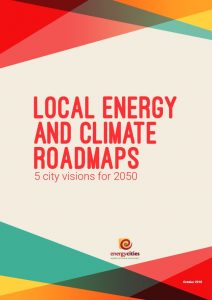How Münster´s sufficiency strategy helped to overcome three universal challenges
No transformation without a vision
The city of Münster has bold 2050 goals: being almost climate neutral while reducing their final energy consumption by 50% and their GHG emissions by 95% compared to 1990.
But how do you do that? This is the crux of the issue for Münster and all progressive cities.
- You can’t mandate people to completely change all of their consumption patterns at an individual, household or enterprise level.
- Increasing energy efficiency alone isn’t enough to create the necessary changes in housing, energy consumption in appliances, transportation, to say nothing of solid waste, food and water.
- Even if it was possible to increase efficiency enough – there is the risk that behaviours change to negate those savings. For example, with the switch to LEDs, which are much more efficient than other lights, has been accompanied by a huge increase in the number of lights offsetting much of the carbon savings. (Impress your friends by referring to this as the Jevons Paradox)
The short answer is sufficiency.
The longer answer is during the development process of their roadmap, the city of Münster realised that increasing sufficiency potentials was key to unlocking the required savings. To increase sufficiency, they needed a systematic approach to changing behaviour as part of their energy policy. Münster developed an entire strategy to initiate that transformation process.
| Why Sufficiency matters |
|---|
| Sufficiency is a complement to consistency and to efficiency. While efficiency allows us to do things the right way (e.g. save energy with efficient technologies and appliances), sufficiency empowers us to do the right things. For example, efficient cars only save energy if car drivers do not drive more frequently than before or even buy larger cars, which would then lead to a rebound effect. The decision to not buy a larger car or to not use the car more frequently but rather question the usage of it in general would be based on sufficiency/ a sufficient lifestyle. While energy efficiency means using the required services but with less energy, sufficiency leads to the idea that the service as such is not adequate/ not required and so avoids the rebound effect. |
A Strategy for Sustainable Decision-Making
A number of citizens participated in workshops, discussions, interviews and consultations to help develop the strategy. This open and cooperative exchange shall also be the design for the strategy´s implementation and collaboration.
The result is that instead of considering sufficiency as a sacrifice, Münster´s strategy considers it as the right balance of energy and resource use according to the 2050 roadmap. It helps ensure that behavioural changes and consumption patterns are in line with the roadmap´s targets. As such, it is a guiding principle for sustainable climate and resource protecting decisions, targeting the decision-maker from an individual-to an institutional level.

Sufficiency as a pillar for a climate neutral city
While it is becoming ever clearer that without sufficiency potentials, no climate strategy will be entirely successful, research on the topic is growing and definitions of sufficiency are diverging. Instead of seeing sufficiency in relation to decisions and behaviour, the European Council for an Energy Efficient Economy defines energy sufficiency rather as “an overall state or goal and as an organising principle for policies that may go beyond traditional areas for energy policy”. It is therefore undeniable that time has come to foster a broader political discussion on energy sufficiency.
| Discover the visions of four other cities in Europe in our publication Local energy & climate roadmaps: 5 city visions for 2050 |

